Orkney’s first evening with us delivers a blue chalk canvas framed by tumbleweed clouds. The sky threatens to swallow the small, flat land beneath it, but erect megaliths like those here, the Standing Stones of Stenness, hold up the heavens like ancient tent poles. I stop inside the gate and watch sheep quietly munch the turf back to its roots. I wish I’d brought beers or whisky, something intoxicating, to amplify the subtle, dissociative effect of the place. Only four stones remain standing of what was once an elliptical henge monument. Scientists and anthropologists have theories for their purpose, but they stick like notebook paper scotch-taped to the stones. And in this wind?
So often in these writings I vainly seek for the true meaning of things, the origins and the motivations. I don’t think I’m alone. Where does this desire to label and organize everything in our surroundings come from? Why must everything hang on a peg, lie in a box, or rest on a shelf of our creation? There was a moment here as the wind sieved through the sheeps’ wool and the sun limned the uniform angled tops of the stones when I felt anything was possible, that anything could happen, and the stones suddenly looked like earthly bridges to the firmament.


It’s an amazing feeling standing in the presence of something like this (or Maes Howe or Skara Brae). Hopefully, Scotland will always preserve these wonderful symbols of its own and humankind’s prehistory.
Next time I get to Scotland, I’d like to go to the Orkneys. Scara Brae, Brough of Birsay, Steness standing stones, Broch o’ Gurness and Stromness.
All worthwhile stops. Don’t forget my favorite, The Ring of Brodgar.